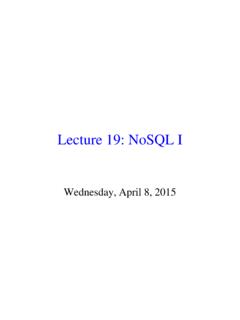Transcription of CS429: Computer Organization and Architecture ...
1 cs429 : Computer Organization and Architecture Instruction Set Architecture Dr. Bill Young Department of Computer Science University of Texas at Austin Last updated: October 2, 2019 at 18:05. cs429 Slideset 6: 1 Instruction Set Architecture Topics of this Slideset Intro to Assembly language Programmer visible state Y86 Rudiments RISC vs. CISC architectures cs429 Slideset 6: 2 Instruction Set Architecture Instruction Set Architecture Assembly Language View Processor state: registers, memory, etc. instructions and how instructions are encoded Layer of Abstraction Above: how to program Application Program machine, processor executes instructions sequentially Compiler OS.
2 1111111111111. 0000000000000. Below: What needs to be 0000000000000. 1111111111111. 0000000000000. 1111111111111. 0000000000000. 1111111111111. 0000000000000. 1111111111111. ISA. 0000000000000. 1111111111111 ISA Layer built 0000000000000. 1111111111111. 0000000000000. 1111111111111. Use variety of tricks to CPU Design make it run faster Circuit Design , execute multiple instructions Chip Layout simultaneously cs429 Slideset 6: 3 Instruction Set Architecture Why Y86? The Y86 is a toy machine that is similar to the x86 but much simpler. It is a gentler introduction to assembly level programming than the x86. just a few instructions as opposed to hundreds for the x86.
3 Fewer addressing modes;. simpler system state;. absolute addressing. Everything you learn about the Y86 will apply to the x86 with very little modification. But the main reason we're bothering with the Y86 is because we'll be explaining pipelining in that context. cs429 Slideset 6: 4 Instruction Set Architecture Language / Machine Semantics There are various means of giving a semantics or meaning to a programming system. Probably the most sensible for an assembly (or machine) language is an operational semantics, also known as an interpreter semantics. That is, we explain the semantics of each possible operation in the language by explaining the effect that execution of the operation has on the machine state.
4 cs429 Slideset 6: 5 Instruction Set Architecture Fetch / Decode / Execute Cycle The most fundamental abstraction for the machine semantics for the x86/Y86 or similar machines is the fetch-decode-execute cycle. This is also called the von Neumann Architecture . The machine repeats the following steps forever: 1 fetch the next instruction from memory (the PC tells you which is next);. 2 decode the instruction (in the control unit);. 3 execute the instruction, updating the state appropriately;. 4 go to step 1. cs429 Slideset 6: 6 Instruction Set Architecture Y86 Processor State Program Condition Memory Registers codes OF ZF SF. %rax %rsp %r8 %r12.
5 %rcx %rbp %r9 %r13. %rdx %rsi %r10 %r14 PC Stat %rbx %rdi %r11. Program registers: almost the same as x86-64, each 64-bits Condition flags: 1-bit flags set by arithmetic and logical operations. OF: Overflow, ZF: Zero, SF: Negative Program counter: indicates address of instruction Memory Byte-addressable storage array Words stored in little-endian byte order Status code: (status can be AOK, HLT, INS, ADR) to indicate state of program execution. cs429 Slideset 6: 7 Instruction Set Architecture Y86 instructions We're actually describing two languages: the assembly language and the machine language. There is nearly a 1-1 correspondence between them.
6 Machine Language instructions 1-10 bytes of information read from memory Can determine instruction length from first byte Not as many instruction types and simpler encoding than x86-64. Each instruction accesses and modifies some part(s) of the program state. cs429 Slideset 6: 8 Instruction Set Architecture Y86 Instruction Set Byte 0 1 2 3 4 5 6 7 8 9. halt 0 0. nop 1 0. cmovXX rA,rB 2 fn rA rB. irmovq V,rB 3 0 F rB V. rmmovq rA,D(rB) 4 0 rA rB D. mrmovq D(rB),rA 5 0 rA rB D. OPq rA,rB 6 fn rA rB. jXX Dest 7 fn Dest call Dest 8 0 Dest ret 9 0. pushq rA A 0 rA F. popq rA B 0 rA F. cs429 Slideset 6: 9 Instruction Set Architecture Example from C to Assembly Suppose we have the following simple C program in file int sumInts ( long int n ).
7 {. /* Add the integers from n . */. long int i ;. long int sum = 0;. for ( i = 1; i <= n ; i ++ ) {. sum += i ;. }. return sum ;. }. We used long int to force usage of the 64-bit registers. You can generate assembly using the following command: > gcc -O -S cs429 Slideset 6: 10 Instruction Set Architecture x86 Assembly Example .file ..text .globl sumInts .type sumInts , @function sumInts : .LFB0 : .cfi startproc testq %r d i , %r d i jle .L4. movq $0 , %r a x movq $1 , %r d x .L3 : addq %r d x , %r a x addq $1 , %r d x cmpq %r d x , %r d i jge .L3. ret .L4 : movq $0 , %r a x ret .cfi endproc .LFE0 : .size s u m I n t s , . s u m I n t s.
8 Ident GCC : ( Ubuntu 4 . 8 . 4 2u b u n t u 1 14 . 0 4 ) 4 . 8 . 4 .. s e c t i o n . s cs429 Slideset 6: 11t a c k Instruction , , @ pSet r oArchitecture gbits Y86 Assembly Example This is a hand translation into Y86 assembler: sumInts : andq % rdi , % rdi # test % rdi = n jle .L4 # if <= 0 , done irmovq $1 , % rcx # constant 1. irmovq $0 , % rax # sum = 0. irmovq $1 , % rdx # i = 1..L3 : rrmovq % rdi , % rsi # temp = n addq % rdx , % rax # sum + = i addq % rcx , % rdx # i += 1. subq % rdx , % rsi # temp -= i jge .L3 # if >= 0 , goto L3. ret # else return sum .L4 : irmovq $0 , % rax # done ret How does it get the argument? How does it return the value?
9 cs429 Slideset 6: 12 Instruction Set Architecture Encoding Registers Each register has an associated 4-bit ID: %rax 0 %r8 8. %rcx 1 %r9 9. %rdx 2 %r10 A. %rbx 3 %r11 B. %rsp 4 %r12 C. %rbp 5 %r13 D. %rsi 6 %r14 E. %rdi 7 no reg F. Almost the same encoding as in x86-64. Most of these registers are general purpose; %rsp has special functionality. cs429 Slideset 6: 13 Instruction Set Architecture Y86 Instruction Set (2). cmovXX rA,rB 2 fn rA rB. Encompasses: rrmovq rA,rB 2 0 move from register to register cmovle rA,rB 2 1 move if less or equal cmovl rA,rB 2 2 move if less cmove rA,rB 2 3 move if equal cmovne rA,rB 2 4 move if not equal cmovge rA,rB 2 5 move if greater or equal cmovg rA,rB 2 6 move if greater cs429 Slideset 6: 14 Instruction Set Architecture Y86 Instruction Set (3).
10 OPq rA,rB 6 fn rA rB. Encompasses: addq rA,rB 6 0 add subq rA,rB 6 1 subtract andq rA,rB 6 2 and xorq rA,rB 6 3 exclusive or cs429 Slideset 6: 15 Instruction Set Architecture Y86 Instruction Set (4). jXX Dest 7 fn Dest Encompasses: jmp Dest 7 0 unconditional jump jle Dest 7 1 jump if less or equal jl Dest 7 2 jump if less je Dest 7 3 jump if equal jne Dest 7 4 jump if not equal jge Dest 7 5 jump if greater or equal jg Dest 7 6 jump if greater cs429 Slideset 6: 16 Instruction Set Architecture Simple Addressing Modes Immediate: value irmovq $0xab, %rbx Register: Reg[R]. rrmovq %rcx, %rbx Normal (R): Mem[Reg[R]]. Register R specifies memory address.









